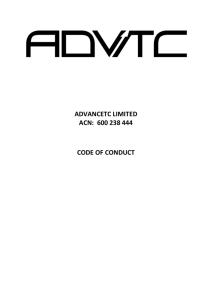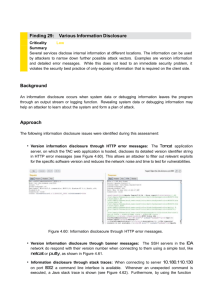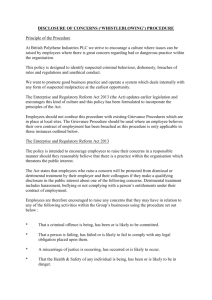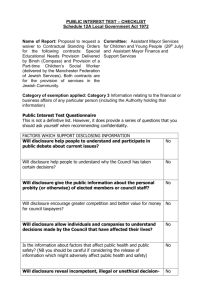“Disclosure is necessary but not sufficient for effective
advertisement
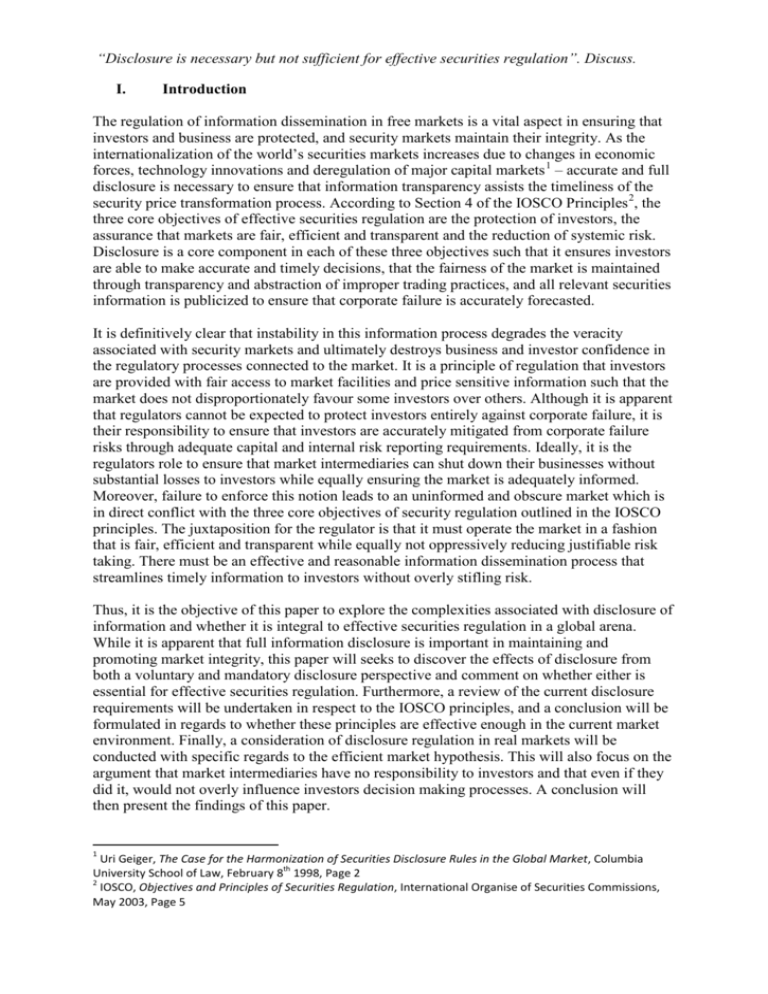
“Disclosure is necessary but not sufficient for effective securities regulation”. Discuss. I. Introduction The regulation of information dissemination in free markets is a vital aspect in ensuring that investors and business are protected, and security markets maintain their integrity. As the internationalization of the world’s securities markets increases due to changes in economic forces, technology innovations and deregulation of major capital markets 1 – accurate and full disclosure is necessary to ensure that information transparency assists the timeliness of the security price transformation process. According to Section 4 of the IOSCO Principles 2, the three core objectives of effective securities regulation are the protection of investors, the assurance that markets are fair, efficient and transparent and the reduction of systemic risk. Disclosure is a core component in each of these three objectives such that it ensures investors are able to make accurate and timely decisions, that the fairness of the market is maintained through transparency and abstraction of improper trading practices, and all relevant securities information is publicized to ensure that corporate failure is accurately forecasted. It is definitively clear that instability in this information process degrades the veracity associated with security markets and ultimately destroys business and investor confidence in the regulatory processes connected to the market. It is a principle of regulation that investors are provided with fair access to market facilities and price sensitive information such that the market does not disproportionately favour some investors over others. Although it is apparent that regulators cannot be expected to protect investors entirely against corporate failure, it is their responsibility to ensure that investors are accurately mitigated from corporate failure risks through adequate capital and internal risk reporting requirements. Ideally, it is the regulators role to ensure that market intermediaries can shut down their businesses without substantial losses to investors while equally ensuring the market is adequately informed. Moreover, failure to enforce this notion leads to an uninformed and obscure market which is in direct conflict with the three core objectives of security regulation outlined in the IOSCO principles. The juxtaposition for the regulator is that it must operate the market in a fashion that is fair, efficient and transparent while equally not oppressively reducing justifiable risk taking. There must be an effective and reasonable information dissemination process that streamlines timely information to investors without overly stifling risk. Thus, it is the objective of this paper to explore the complexities associated with disclosure of information and whether it is integral to effective securities regulation in a global arena. While it is apparent that full information disclosure is important in maintaining and promoting market integrity, this paper will seeks to discover the effects of disclosure from both a voluntary and mandatory disclosure perspective and comment on whether either is essential for effective securities regulation. Furthermore, a review of the current disclosure requirements will be undertaken in respect to the IOSCO principles, and a conclusion will be formulated in regards to whether these principles are effective enough in the current market environment. Finally, a consideration of disclosure regulation in real markets will be conducted with specific regards to the efficient market hypothesis. This will also focus on the argument that market intermediaries have no responsibility to investors and that even if they did it, would not overly influence investors decision making processes. A conclusion will then present the findings of this paper. 1 Uri Geiger, The Case for the Harmonization of Securities Disclosure Rules in the Global Market, Columbia th University School of Law, February 8 1998, Page 2 2 IOSCO, Objectives and Principles of Securities Regulation, International Organise of Securities Commissions, May 2003, Page 5 II. Disclosure Requirements The fundamental purpose of disclosure is to provide investors with information necessary to make an informed investment decision on an ongoing basis. 3 The information on which they base their decision needs to be accurate and timely so that their assessment of a market intermediary is a truthful reflection of its current position. The achievement of this goal ensures that investment decisions will be improved, shareholder sentiment and value will be enhanced and questionable management conduct can be deterred 4. Obviously, the direct and indirect disclosure costs in ensuring that this goal is feasible, associated with the precision of recording, processing, auditing, publishing and reporting all the relevant information are increasingly high 5. As an intermediary grows in market capitalisation, this process becomes more difficult and costly – with the identification of market sensitive information being progressively more complex. The IOSCO Principles 6 provide a standardised benchmark for information which is considered more price sensitive and relevant to investors. According to s10.4 this includes information directly related to: • Offering of securities for public sale; • Content and distribution of prospectuses or other offering documents; • Advertising in connection with securities; • Information about those who have a significant interest in a listed company; • Information about those who seek control of a company; • Information material to the price or value of a listed security; • Periodic financial reporting; • Shareholder voting decisions. The disclosure of information directly related to above points is deemed to have an immediate pricing effect on a securities market value and as a result, this information is critical to an investor’s decision making process. However, it is becoming increasingly apparent that market intermediaries are standardizing their disclosure practices as an indicator of performance periodically7. This allows them to have a standardized release platform for the disclosure of market sensitive information rather than engage in the expensive cost determination of establishing whether the information is required to be disclosed. The difficulty for the regulator in market intermediaries adopting such an approach is the assurance that all market information is released in a timely and accurate manner. Furthermore, once a disclosure methodology becomes standard practice and investors expect information dissemination on a periodic basis - any divergence from this cycle may send pessimistic signals to the market place. Thus, the role of the regulator in reviewing the cyclical release of information becomes an integral argument in relation to whether disclosure is entirely sufficient for effective securities regulation. It can be argued that cyclical disclosure of information incites cyclical 3 Ibid 2, Page 23 Little, The Policy Underlying Financial Disclosure by Corporations and its effect on Legal Liability, 1991, 1 Aust J Corp L 97 at 104 5 Benson, An Appraisal of the Costs and Benefits of Government-Required Disclosure: SEC and FTC Requirements, 1977, 41 Law & Cont Prob 30 at 41 6 Ibid 2, Page 22 7 Ibid 1, Page 3 4 buying and selling patterns in an underlying securities market value, thereby promoting market manipulation. The objective of the regulator is to ensure that disclosure of price sensitive information is timely and relevant, and clearly the adoption of cyclical release methodologies does not promote this objective. However, there must be a fair and equitable balance between the costs associated with disclosure and the point at which information is released. While it is clear that information dissemination is critical to an investor’s decision making process, the economic cost of capital in releasing timely and relevant information must also be considered in the regulators consideration of what is price sensitive. Evidently, implementing disclosure laws with this in mind would be advantageous to market intermediaries such that it provides them with a financial incentive to disclosure more information. Opponents of such an approach would argue that the adoption of such a policy would allow for increased subjective interpretation of information disclosure, and would subsequently provide more discretion to market intermediaries to determine what information is relevant and what is not. In addition it would be argued such a policy aligns itself with voluntary disclosure principles and moves away from the current standardised disclosure legislation. Consequently, it is more valuable for regulators to adopt a combinatory approach incorporating both mandatory and voluntary disclosure principles within a specified time period. III. Mandatory & Voluntary Disclosure It can be seen that both governments 8 and securities regulators believe the disclosure of information is an essential aspect of securities regulation. In particular, as s10 of the IOSCO principles state, all information released must be in a full, accurate and timely manner. However, the IOSCO principles do not draw conclusions between the adoption of either mandatory or voluntary disclosure laws and provide a discussion of which is more effective rather stating that any ‘information which is material to investor’s decisions’ be disclosed. It is apparent that this has been interpreted as a mandatory disclosure directive, and as a result, there has been considerable debate regarding the positive net value of mandatory disclosure principles. Some commentators have queried the effectiveness of mandatory disclosure rules 9, suggesting that market forces will always force information dissemination to occur and produce perfect disclosure practices. 10 However, others have suggested 11 without mandatory disclosure legislation the market will ultimately fail, as market intermediaries will only release positively correlated pricing information. It is apparent that an absolute implementation of either voluntary or mandatory disclosure is not optimal, but rather the establishment of an appropriate equilibrium between the two. Mandatory disclosure requirements are an important component of securities regulation because they force market intermediaries to publish relevant information about their operations. Unfortunately, a critical problem created by the adoption of mandatory disclosure is that there are no direct incentives offered to market intermediaries to provide relevant information or more detailed disclosures 12. While regulators have created some motivation for market intermediaries to provide full and accurate disclosure through laws prohibiting misleading and deceptive conduct, their effectiveness is questioned. In fact, an Australian 8 According to the Australian Corporate Law Reform Bill (No 2) 1992 – “The government considers it essential that there be timely disclosure of relevant information about the financial position and prospects of entities in which Australia Invests.” 9 Benston, The Value of the SEC’s Accounting Disclosure Requirements, 1969, 44 Acc Rev 515 10 Stigler, Public Regulation of the Securities Markets, 1964, 27J Bus 117 11 Seligman, The Historical Need for a Mandatory Corporate Disclosure System, 1983, 9 J Corp L 1 12 Easterbrook and Fischel, Mandatory Disclosure and the Protection of Investors, 1984, 70 Birg L Rev 669 at 674-680 study was published in 1996 which concluded there was no strong evidence that continuous and mandatory disclosure legislation had any significant impact on the efficiency of the Australian share market or on the disclosure practices of relevant listed companies 13. This highlights that mandatory disclosure requirements may not be as effective as regulators intend them to be and questions the value of full mandatory disclosure adoption in securities regulation. In direct constant to mandatory disclosure, voluntary disclosure focuses entirely on the efficiency of market intermediaries and their desire to mitigate corporate risk by increasing information transparency through purposeful disclosure. It can be argued that it is easier for management to reduce their personal liability by actively informing the market about relevant price sensitive material. The problems associated with voluntary disclosure typically stem from correlation between the size of the market intermediary and the financial impact of the information being disclosed. In market intermediaries with a smaller market capitalisation, negative information typically ignites greater pricing volatility than on larger market intermediaries releasing the same type of information 14. It is also suggested 15 that the timing of releases becomes a more predominate concern for regulators, since market intermediaries usually only release information in advantageous circumstances. Furthermore, it is plausible that voluntary disclosure leads to formation of information release strategies which are distinctly advantageous to market intermediaries, and are in no way deliver timely, accurate and relevant information to investors. Therefore, it is evident that securities regulators cannot adopt an absolute approach to voluntary and mandatory disclosure, but rather aim to implement disclosure policies which facilitate both disclosure regimes and ultimately ensure that investors are protected, and fraud and misconduct are reduced. Currently, it is obvious that there are a range of informed investors – stemming from those who are completely uninformed to those who are extremely well informed 16. In order for disclosure to be entirely sufficient in securities regulation, a system needs to be implemented that ensures that all investors are completely informed of market activities and all have equivalent access to corporate information. Furthermore, methodologies need to be adopted which increase the simplification of the information dissemination process and ensure that all investors can realistically understand the information being disclosed. This development of such a system would be founded on the argument that unsophisticated investors require additional market protection, and that current disclosure frameworks do not allow for information to be comprehended simply and efficiently. It has been argued that information which is disclosed to unsophisticated investors in a complex manner is ultimately useless in their decision making process 17 and does not advocate the IOSCO principles. While it would seem obvious that complex information is usually interpreted immediately by sophisticated institutional investors who determine the relevant pricing effect - empirical evidence suggests otherwise. It supports the view that securities markets exhibit semi-strong form efficiency and that prices react quickly to any publicly released information such that no 13 Brown, Taylor and Walter - Companies and Securities Advisory Committee, Report on Continuous Disclosure, 1996, Page 9-10 14 Ibid 13 15 Ibid 12 16 G. Mitu Gulati & Stephen J. Choi, An Empirical Study of Securities Disclosure Practices, New York University School of Law, 2006, Page 3 17 Hirshleifer, The Private and Social Value of Information and the Reward to Inventive Activity, 1971, Am Econ Rev 561 single investor has an advantage over another 18. While this may be true for market intermediaries with a large market capitalisation, it is not necessarily accurate for securities which are thinly traded or have a smaller market capitalisation. Thus, it is useful to examine the concept of efficient market hypothesis and its effect on real markets. IV. Real Markets & Efficient Market Hypothesis It is nonsensical to discuss the notion of disclosure efficiency in securities regulation without discussing the actual effect of disclosure and the dissemination of information in real markets. An important relationship which is relevant to the effectiveness of disclosure is a comparison of the efficient markets concept with mandatory disclosure principles 19. Before drawing comparisons between the two, it is important to note that there are distinct differences between informational efficiency and allocative efficiency20, since an informationally efficient market does not automatically imply that it is also an allocatively efficient market. Additionally, it important to realise that informationally efficient markets do not entirely encompass management behaviour since all information is automatically encompassed within the securities price 21. An efficient capital market is a market in which all information is reflected in the underlying price of security as soon as it becomes available. This suggests that security prices are unbiased estimates of the future value of a security, and that they react immediately to the release of any new information 22. Thus, the efficient capital market theory concludes that there is almost no advantage gained by institutional investors spending time and energy on securities research and analysis 23 as price will automatically encompass all relevant information. Consequently, this assumes that the information dissemination process occurs instantaneously and there is no time lag between the disclosure of the market information and its relevant interpretation of it. While it can be argued that this is not rationally achievable in real markets, proponents of the efficient market concept suggest that it is. They argue that there is no need for mandatory or voluntary disclosure regulations since there are adequate market incentives available to issuers to make accurate, complete and timely disclosures without breaching any of the relevant disclosure regulations 24. Conversely, opponents of the efficient market hypothesis suggest since all information is fully reflected in a securities market price – prices will not reflect private or unavailable information which does still arrive in the market. This an important aspect of efficient market hypothesis since it does not facilitate this concept and as a result, is negatively correlated to mandatory disclosure ideologies which seek to ensure that all information – whether private or public - is consistently made available to investors 25. Of course, the notion that 18 Wikipedia, Efficient Market Hypothesis, http://en.wikipedia.org/wiki/Efficient_market_hypothesis, 2007, th Viewed May 6 2007 19 Mark Blair and Ian Ramsay, Mandatory Corporate Disclosure Rules and Securities Regulation, LBC information Services, 1998, Page 65 20 Informationally efficient markets are those that exhibit strong market efficiency and as a result, security prices automatically encompass any newly released information. Allocative efficient markets are those that allocate resources to the most efficient users and as a result, security prices tend to reflect those which the most influence on the market. 21 R. Jenningsm H.Marsh, J. Coffee and J.Seligman, Securities Regulation Cases and Material, Foundation Press, 1998, At 239 22 Ibid 21 23 Dimity Kingsford Smith, Importing the e-World into Canadian Securities Regulation, Canadian Securities Commission, 2006, Page 303 24 F. H. Easterbrook and D. R. Fishel, The Economic Structure of Corporate Law, 1991, Pages 286-290 25 Ibid 24 unregulated markets are effective is unfounded because there is no empirical evidence available to provide otherwise. Thus, the efficient market hypothesis is rather an ideology that attempts to draw conclusions between the theoretical world of securities regulation and the real one. While such conclusions are useful in the consideration of perfect capital markets, the ability to transfer these conclusions to real markets which are considered semiefficient at best, are ineffective. Specifically, the large disparity between the information efficiency of larger companies compared to smaller companies, and the level of active trading that occurs between the two suggests that efficient market hypothesis cannot work in its pure form in real securities markets. Furthermore, the failure for the efficient market hypothesis to encompass management behaviour in the information dissemination process renders the adoption of the hypothesis futile in the real world, and in no way reduces the information asymmetry between market intermediaries and investors. Interestingly, the concept of efficient market hypothesis was tested in the Australian High Court in relation to share valuations in Gambotto v WCP Ltd 26. This case spearheaded the establishment of new rules for when majority shareholders are able to seize shares of minority shareholders, with the full high court concluding that a shareholder’s interest cannot be valued solely on a market price. 27 Additionally, research has suggested that market intermediaries have no responsibility to react to unsophisticated investors needs, and even if they did, it would make no difference 28. Research has suggested 29 that unsophisticated investors tend to have a number of biases such as egotism, over confidence and an unwillingness to accept failure by holding a security even in a bear market. As concluded in the Gambotto v WCP Ltd, unsophisticated investors tend to ‘follow the herd’ and do not use any available information in their decision making process. This type of market behaviour causes extreme price volatility and is based on imperfect investor reasoning - a concept that the efficient market hypothesis failures to accurately explain. Thus, it is apparent that while investors do attempt to disseminate information in primary markets 30 they tend to typically adopt a ‘herd mentality’ in secondary markets. This forms the reasonable conclusion that while the efficiency market hypothesis is a useful theoretical concept, it is not entirely sustainable in real markets. V. Conclusion This paper has examined the concepts of disclosure and commented on the current rationales for mandatory, voluntary and free market disclosure. While it is apparent that one absolute approach to disclosure is not the most effective regulatory response, it is also clear that in the current market environment disclosure is merely necessary and not entirely sufficient. The principles stated in IOSCO tend to infer that the implementation of mandatory disclosure legislation is preferred, yet there is no clear evidence which supports the adoption of this inference wholeheartedly. Although some empirical evidence has suggested that information is digested quickly by the market, conflicting research has also concluded that this is only the 26 Gambotto v WCP Ltd 1995 182 CLR 432 Mason CJ and Brennan, Deane and Dawson JJ stated “Share markets are driven by many factors, not all of them rational or fair... the histories of stock markets are overrun by examples of companies whose intrinsic value remained unnoticed for too long. This ‘herd mentality’ exists in stock markets as in other areas of life..... It is important to emphasise that a shareholders’ interest cannot be valued solely by the current market value of the shares. Whether the price offered is fair depends on a variety of factors, including assets, market value, dividends and the nature of the corporation and its future.” 28 Ibid 23, Page 305 29 D Langevoort, Taming the Animal Spirits of the Stock Market: A Behavioural Approach to Securities Regulation, Berkley Olin Program in Law and Economics, 2002, Paper 64 30 Niklas Strom, Initial Public Offerings Disclosure Strategy, Uppsala University, Working Paper Series, 2005 27 case in instances where sophisticated investors firstly interpret the information, and then the rest of the market adopts a ‘herd-like’ mentality. Currently, the international regulatory response to disclosure has been to follow the IOSCO principles and enforce the stricter mandatory disclosure principles on market intermediaries to ensure the market remains fair. The cost of this ideology has been that unsophisticated investors’ still remain uninformed and struggle with the interpretation of relevant information, forcing them to seek qualified economic advice in order to understand the financial implications of the information released. While it is clear that corporate management have no incentives to provide additional interpretation or tiering of information, it is recommended that this is most sensible approach moving forward in order to increase the transparency of market intermediaries and ensure the entire market is adequately informed. Clearly, in order to satisfy the IOSCO principles of disclosure in informing the market of material which is relevant to an investor’s decision making process, the information dissemination method needs to change. If regulatory bodies accept that the majority of unsophisticated investors are unlikely to understand the bulk of information disclosed by corporate entities, then it must be accepted that current disclosure legislation is not sufficient in ensuring the entire market is informed or that current disclosure practices are effective. A system needs to be developed that not only incorporates the cost of disclosure to corporate entities, but also ensures that tiering of information is made available to all investors so it can be interpreted by the whole market in a timely and accurate manner. Adopting an approaching that allows different investors to select which information is relevant to their level of technical understanding is the most sensible method of ensuring that market intermediaries accurately inform investors of relevant information. Key features of such approach would be the release of multiple disclosures which each uniquely summarise the most technically advanced document, and ensure that all investors are accurate able to interpret the all relevant information. The obvious criticism of implementing such a disclosure system is the cost to market intermediaries in preparing and releasing the information. However, if a clear set of guidelines was established as to what each document would be required to contain, the process could quite easily be automated by computer systems which could extrapolate all required information automatically. Evidently, as securities markets increasingly digitise themselves, this process would be made easier. Thus, it is evident that current disclosure legislation adopted by international securities markets is not sufficient in ensuring the market is adequately informed. Significant changes need to be adopted to ensure that all market participants can actively interpret information which is disseminated to the market. This increases the ability for investors to accurately understand information in their decision making process and will optimistically reduce the herd mentality adopted by many investors. While it can be argued that cost of implementing this process will far outweigh the benefits, it is concluded that in order for disclosure to be sufficient in securities regulation - it is the most rational option. Bibliography 1. Uri Geiger, The Case for the Harmonization of Securities Disclosure Rules in the Global Market, Columbia University School of Law, February 8th 1998, Page 2 2. IOSCO, Objectives and Principles of Securities Regulation, International Organise of Securities Commissions, May 2003, Page 5 3. Little, The Policy Underlying Financial Disclosure by Corporations and its effect on Legal Liability, 1991, 1 Aust J Corp L 97 at 104 4. Benson, An Appraisal of the Costs and Benefits of Government-Required Disclosure: SEC and FTC Requirements, 1977, 41 Law & Cont Prob 30 at 41 5. Australian Corporate Law Reform Bill (No 2) 1992 – “The government considers it essential that there be timely disclosure of relevant information about the financial position and prospects of entities in which Australia Invests.” 6. Benston, The Value of the SEC’s Accounting Disclosure Requirements, 1969, 44 Acc Rev 515 7. Stigler, Public Regulation of the Securities Markets, 1964, 27J Bus 117 8. Seligman, The Historical Need for a Mandatory Corporate Disclosure System, 1983, 9 J Corp L 1 9. Easterbrook and Fischel, Mandatory Disclosure and the Protection of Investors, 1984, 70 Birg L Rev 669 at 674-680 10. Brown, Taylor and Walter - Companies and Securities Advisory Committee, Report on Continuous Disclosure, 1996, Page 9-10 11. G. Mitu Gulati & Stephen J. Choi, An Empirical Study of Securities Disclosure Practices, New York University School of Law, 2006, Page 3 12. Hirshleifer, The Private and Social Value of Information and the Reward to Inventive Activity, 1971, Am Econ Rev 561 13. Wikipedia, Efficient Market Hypothesis, http://en.wikipedia.org/wiki/Efficient_market_hypothesis, 2007, Viewed May 6th 2007 14. Mark Blair and Ian Ramsay, Mandatory Corporate Disclosure Rules and Securities Regulation, LBC information Services, 1998, Page 65 15. R. Jenningsm H.Marsh, J. Coffee and J.Seligman, Securities Regulation Cases and Material, Foundation Press, 1998, At 239 16. Dimity Kingsford Smith, Importing the e-World into Candaian Securities Regulation, Candian Securities Commission, 2006, Page 303 17. F. H. Easterbrook and D. R. Fishel, The Economic Structure of Corporate Law, 1991, Pages 286-290 18. Gambotto v WCP Ltd 1995 182 CLR 432 19. D Langevoort, Taming the Animal Spirits of the Stock Market: A Behavioural Approach to Securities Regulation, Berkley Olin Program in Law and Economics, 2002, Paper 64 20. Niklas Strom, Initial Public Offerings Disclosure Strategy, Uppsala University, Working Paper Series, 2005


